 Holography Defined
Holography Defined Laser Light
Laser Light Coherence
Coherence Electro Magnetic Radiation
Electro Magnetic Radiation Light Described
Light Described Light Amplification
Light Amplification Feedback
Feedback Helium-Neon Laser
Helium-Neon Laser Photon Emission
Photon Emission Energy
Energy Photographic Film
Photographic Film Resolving Power
Resolving Power Compared to a Photograph
Compared to a Photograph Reference Beam
Reference Beam Beam Splitter
Beam Splitter Interference
Interference Use
Use  Isolation
Isolation Acoustic Vibration
Acoustic Vibration  Absorption Holograms
Absorption Holograms Phase Holograms
Phase Holograms Basis of Definition
Basis of Definition Angle Difference
Angle Difference Early Experiments
Early Experiments Transmission Holograms
Transmission Holograms Off-Axis Referance Beam
Off-Axis Referance Beam Plane and Volume Holograms
Plane and Volume Holograms Reflection Holograms
Reflection Holograms Real Image, Virtual Image
Real Image, Virtual Image Pseudo Scopic Image
Pseudo Scopic Image Multipex Holograms
Multipex Holograms  Purity of Light
Purity of Light Path Measurement
Path Measurement  Isolation Table
Isolation Table Interferometer
Interferometer Darkroom
Darkroom Optics and Optical Mounts
Optics and Optical Mounts Photographic Supplies
Photographic Supplies Light Meter
Light Meter  Selecting Objects
Selecting Objects Basic Transmission Hologram
Basic Transmission Hologram To Measure Beam Ratios
To Measure Beam Ratios Reconstruction
Reconstruction Basic Reflection Holograms
Basic Reflection Holograms Reconstruction
Reconstruction  Division of Amplitude Transmission
Division of Amplitude Transmission Holograms
Holograms Multiple Object Beam Transmission
Multiple Object Beam Transmission Real Image Projection
Real Image Projection Transmission Hologram
Transmission Hologram Greater Depth of Field
Greater Depth of Field 360' Transmission Hologram
360' Transmission Hologram Image Reflection Hologram
Image Reflection Hologram Twin-Beam Reflection Hologram
Twin-Beam Reflection Hologram  Bromine Technique
Bromine Technique  Glossary
Glossary Equipment
Equipment Schools
Schools Manufacturers and Distributors
Manufacturers and Distributors Bibliography
BibliographySome of the questions about holography which come to mind immediately might serve as a good starting point for our discussion. They are: "What is a hologram? And how does holography work?" Note that the process is referred to as holography while the plate or film itself is referred to as a hologram. The terms holograms and holography were coined by Dennis Gabor (the father of holography) in 1947. The word hologram is derived from the Greek words "holos" meaning whole or complete and "gram" meaning message. Older English dictionaries define a hologram as a document (such as a last will and testament) handwritten by the person whose signature is attached.
The theory of holography was developed by Dennis Gabor, a Hungarian physicist, in the year 1947. His theory was originally intended to increase the resolving power of electron microscopes. Gabor proved his theory not with an electron beam, but with a light beam. The result was the first hologram ever made. The early holograms were legible, but plagued with many imperfections because Gabor did not have the correct light source to make crisp, clear holograms as we can today nor did he use the off axis reference beam which we will describe later. What was the light source he needed? The LASER, which was first made to operate in 1960.
Laser light differs drastically from all other light sources, man-made or natural, in one basic way which leads to several startling characteristics. Laser light can be coherent light. Ideally, this means that the light being emitted by the laser is of the same wavelength, and is in phase. These might be new terms for some of you, so let us form an analogy that might clarify the term coherence.
Let's say that you are flying over a freeway at rush hour, and directly below you is a long tunnel that all the cars must go through. Nothing is strange about the fact that all different styles and makes of motor vehicles emerge from the tunnel at differing velocities. A Cadillac at 75 mph, a Volkswagen at 45 mph, a motorcycle at 60 mph, a truck at 40. The distances between vehicles also vary. Thus you have different types of vehicles at varying speeds, and at constantly changing distances between each other.
But then something vary strange takes place; you see that more and more 1973 Cadillac Coupe de Villes are emerging.
No, wait, look! All the cars coming out of the tunnel are 1973 Cadillac Coupe de Villes, gold with tinted windows, exactly alike, (a situation not totally uncommon in some carefully chosen Southern California suburbs). Not only are they the same year, make and color, but they are all traveling at exactly the same speed and all bumper to bumper, never changing. So that if you just happened to have a stopwatch to hand you would find that the cars are exiting at a rate of one car per second. If you were to leave, or more likely, pass out from the fumes, you would observe upon reawakening that the exit rate of the cars is still exactly one car per second. The cars are in phase.
The way in which coherent light is emitted from a laser is analogous. Keep in mind that although absolute 100% coherence is rarely, if ever, attained, there are certain types of lasers readily available which have sufficient coherent to make excellent off axis holograms.
The light emitted from a laser is all exactly the same type, or make, depending upon the characteristics of the substance which is lasing. I will explain in the next chapter what the term laser means, and how the laser works to give coherent light. Right now it is important to remember that the frequency of laser light is unvarying and that in the same medium, all light, i.e., light of different wavelengths of frequency, travels at the same speed.
It's true that all electromagnetic radiation, including the very small portion we call visible light, travels in a vacuum at the approximate finite speed of 186,000 miles per second. (Note, the velocity of light in a vacuum is one of nature's constants and is referred to by the letter c). Light waves, can oscillate at different frequencies and with correspondingly different wavelengths so that for any given amount of time, say one second, a greater number of shorter wavelengths of (blue) light would be emitted from a laser than longer vavelengths of (red) light. This does not mean that different wavelengths travel at different speeds. Again to the freeway analogy; given the same speed and same distance between cars, more Volkswagens (short wavelength) than Cadillacs (long wavelengths) would pass by a point in the same amount of time.
Now is a good time to define some terms used previously but that you will see throughout this explanation. Wavelength, usually symbolized by the the Greek letter  for lambda, and frequency, symbolized by the Greek letter v pronounced nu, have a reciprocal relationship v
for lambda, and frequency, symbolized by the Greek letter v pronounced nu, have a reciprocal relationship v  = C. The shorter the wavelength, the higher the frequency and vice versa. The amplitude is the height or intensity of the wave. For example, a laser rated at 5mW (milliwatts, or thousandth of a watt) would give off light at the same frequency and wavelength as another laser of the same type rated at 1 mw. But the wave heights of the 5 mw laser light would be five times higher than that of the 1 mw laser.
= C. The shorter the wavelength, the higher the frequency and vice versa. The amplitude is the height or intensity of the wave. For example, a laser rated at 5mW (milliwatts, or thousandth of a watt) would give off light at the same frequency and wavelength as another laser of the same type rated at 1 mw. But the wave heights of the 5 mw laser light would be five times higher than that of the 1 mw laser.
The wavelength is the distance from one crest to the next; this is also one cycle. It seems logical that we would need some constant measure of time in order to count the cycles. This constant unit of time is usually one second. Thus the term cycles per second, or cps., which is often referred to as Hertz or Hz (in honor of the German Physicist Heinrich Rudolph Hertz, who discovered radio waves). The oscillation frequency of electromagnetic radiation in the visible region is approximately 10 Hz. Wavelengths of visible light are between 400 and 700 nanometers or billionths of a meter in length.
We have described light as energy that travels through space in a wave form. For our purposes in talking about holography this is the case. However, the theory of light has unfolded miraculously, involving such great minds as Issac Newton, Thomas Young, Christian Huygens, Max Planck, Niels Bohr and, of course, Albert Einstein. Still, the dual characterist of light remain one of the many puzzles of nature. The particlewave problem which we refer to was clarified somewhat in the year 1900 when Max Planck proposed that all electromagnetic energy is radiated in discrete packages which he called quanta, or singular quantum. Einstein later confirmed Plank's theory via the photoelectric effect and used the word photon to refer to these energy packages. Scientists today refer to light sometimes as particles (photons or quanta) and other times as continuous waves depending on the situation or experiment. The problem is not with nature but with our models or concepts of nature. It is always very important to remember not to let your idea or model of the way anything should be usurp the place in your mind of the way it is or might be. That place should always be open for new information whether it agrees with theory or not.
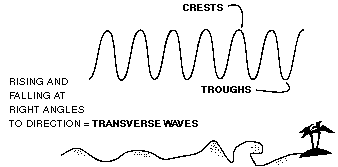
Light travels in a wave form. More precisely, a transverse wave form. The crests and troughs of the waves (which in the case of light are electromagnetic fields) are rising and falling in a direction at right angles to the direction of travel. A swell or wave in the ocean is a good example of transverse wave motion. You'll notice that the rising and falling action of the wave is at right angles to the direction of travel.
A simple proof of the wave theory was first demonstrated by an English physician named Thomas Young in 1802.
He forced the light from a single light source to pass through a narrow slit and then forced that same light to pass through two more narrow slits placed within a fraction of an inch of each other. The light from the two slits fell on a screen. Surprisingly he saw not jut the simple accumulation of the light from both slits on the screen, but a pattern of light and dark lines.
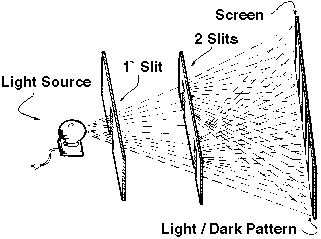
He believed the pattern was the result of the mixing of the waves of light emanating from the respective slits.
At the time it was very difficult for the many justifiably avid fans of Issac Newton to incorporate this new discovery into Newton's particle theory of light. Newton tried to explain optical phenomena such as refraction and reflection in terms of gravitational-like effects. As it turned out later, in a way, Newton's theory was given partial confirmation by the Quantum Theory.
The lines or "fringes" which Young saw, we call the interference pattern of the two light waves. When a crest interferes with a crest it is positive, or constructive interference, resulting in a bright spot. On the other hand, when a crest meets a trough we have a dark area or destructive interference.
As mentioned earlier, light waves oscillate at approximately 10 Hz., or a million billion times per second. There is no machine known to man sensitive enough to record the individual fluctuations additive effect of the light waves of which at each second 10 to the power of 15 wavelengths are interacting on the screen. This number, like so many numbers you may encounter in such fields as physics, astronomy and electronics, is incomprehensible. Yet precise measurement is part and parcel of the advancement of science. Suffice it to say that one billion seconds, for example, equals roughly 30 years, and 10 to the power of 15 seconds is one millions times that.
If the number is so fantastic and if even today we can't measure the waves individually, how did we discover that light was electromagnetic radiation? It's all thanks to the amazingly successful mathematical theory of J. Clark Maxwell, developed in 1864. He predicted not only the electromagnetic nature of light but also the speed at which it travels. Einstein used these same equations as a basis for his theory of special relativity. However, in order to understand exactly how light waves are formed, we had to wait until the year 1900 and the aforementioned Quantum Theory.
Now that we know a little something about light in general, we may consider the light source needed to perform holography: the laser, which stands for light amplification by stimulated emission of radiation. The understanding of the stimulated emission of light, or how a laser works, will greatly aid in conceptualizing the holographic process.
Without the laser, the unique three dimensional imaging characteristics and light phase recreation properties of holography would not exist as we know them today. Two years after the advent of the continuous wave laser, c.1959-1960, Leith & Upatnieks (at the University of Michigan) reproduced Gabor's 1947 experiments with the laser, and launched modern holography.
A laser is a light amplifier, with very special characteristics. The laser was designed and made to work after two very useful theories had come on the scene. One is Niels Bohr's atomic theory and the other is the Quantum Theory. Niels Bohr, a Danish physicist, in the year 1913, proposed a model of the relationship between the electron and nucleus of the hydrogen atom. Bohr utilized the newly developed Quantum Theory in proposing that an electron circling the nucleus can assume certain discrete quantized levels of energy. In the lowest level, called the ground state, the electron is circling closest to the nucleus. However, if the atom is exposed to an outside source of energy the electron can be raised to a higher energy level, or an excited state, which is characterized by the electron carving a circle of greater circumference around the nucleus. It is important to note that the electron can't go just anywhere when it is excited but has to assume certain levels. Also, not just any energy would suffice in raising the electron's orbit. The energy must be equal to the energy difference between the ground state and the excited state the electron assumes. The frequency is the energy difference divided by "h" or Planck's constant. There are actually a number of different energy levels which the electron may assume but that is not essential to this explanation of how a laser works.
Energy is radiated in discrete packages, and these packages interact only on a very selective basis. There are two important reasons why lasers work. The laser depends on the very special emission characteristics of certain atoms whose electrons have been raised to the excited state. When the electron falls back down to its lower energy level (as all electrons eventually do), it in turn emits a package of electromagnetic or radiant energy which precisely equals the energy difference between the two levels, ground state and excited state. In a sense, what goes in comes out. This fact alone doesn't suffice in making a substance lase, for if too many electrons are in the ground state, the energy input would merely be absorbed by the electrons in the ground state which then might spontaneously emit a quantum of the correct size sometime in the future and that would be the end of that. We don't want to have an atom emitting its photon at just any old time, so we stimulate the atom to emit its energy package when we want it to. A package which would not be absorbed by another atom in ground state but would stimulate an atom already in an excited state to emit its own photon. In order to maintain the stimulated emission of photons which produce laser light, you must initiate and mantain a population inversion.
In lasers, electronic principles are applied to the visible portion of the spectrum. In electronics, oscillation is achieved with feedback around an amplifier. The feedback circuit determines the frequency of oscillation. In a laser, the tube of excited atoms is the amplifier. The mirror or resonator is the feedback circuit. Oscillation occurs at those wavelengths where the product of gain equals the loss, for a round trip, say starting from one mirror and coming back again. The gain of a laser is determined by population inversion, or having many more excited electrons, than electrons in the ground state i.e. electrons at their lowest energy level.
The helium-neon laser, which is probably the most common laser in use today (due to its relatively low cost) is the laser you will probably use most. The laser tube itself contains approximately 10% helium and 90% neon. Of these two inert gases, neon is the active agent in the lasing process. We could term helium the catalyst insofar as it facilitates the energy input to the neon. Before more energy is purposefully forced in the system, there is some action among the atoms and molecules comprising the gases. Some although very, very few of the electrons are already in the excited state, or upper energy levels and when they fall down, as they all tend to do, they emit a photon, only to be quickly absorbed.
The gain or loss of a photon or quantum of energy which is defined by a change in electron orbit takes place on the order of 10 to the power of 15 seconds or 100 millionths of a second.
You might ask how even some of the atoms might have electrons in the excited state if there's no energy input, i.e., before the laser is switched on. The answer is purely statistical. For example, if you have a church filled to capacity for a Sunday morning mass, say 250 people, someone has got to cough or sneeze during the sermon. If you take the number of times some two or three people cough and compare that with the amount of times everyone in the curch inhaled and exhaled without occasion, it would give you some idea of the situation in the laser tube before excitation. A few atoms are excited and then fall back to emit energy. This energy in turn goes off spontaneously to another atom whose electron almost certainly is in the ground state. The photon is absorbed. This is the key to the laser. If we have enough atoms with electrons in the excited state, the photon not only would not be absorbed, but when it did reach another excited atom it would induce it to cough up its own photon. We go from one, to two, to four, to eight, to sixteen photons very rapidly. We have achieved population inversion, i.e., many more electrons are in the excited state than in the ground state.
Remember we are considering only the helium-neon laser. It is the most economical laser and probably the one you would be using. There are other lasers such as the argon-ion laser which is able to lase in both blue and green, and better yet a mixed gas argon-krypton ion laser which is able to lase in blue, green and red. The problem is that the prices of these lasers begin at around $6,000. If you have access to these lasers, you probably would not be reading this guide anyway.
There is also the pulse ruby laser which allows you to make holograms of animate objects. In the ruby laser chromium ions locked in a sapphire host are the sources of stimulated emission. The chromium atoms are excited by a light flash from a special flashlamp.
Let's backtrack slightly and talk briefly about the job helium performs before we go on to the more mechanical aspects of laser operation. It so happens that helium has a metastable (or long lived) energy level that coincides quite well with on of the energy levels of neon which we need to obtain for lasing action to commence. Scientists discovered that it is much easier to raise helium to the excited state and let it transfer the correct energy packets to the neon when they meet inside the tube (which is at the correct pressure to assure their close acquaintance). So the helium is used as sort of a messenger, or filter, if you will, to store the correct high energy input origination from the laser power supply for the neon. Although the neon is the active ingredient in the laser, the helium greatly facilitates the process.
Virtually all we have so far, then, is a glorified light tube such as you might find lighting the streets of any late night hot spot worth its salt. The difference from this light tube stage of development to the functioning laser is essencially more of a mechanical characteristic, i.e., the precise geometrical realtionship of its optical components.
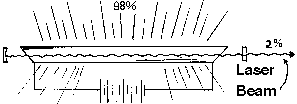
The photons are emitted from the atoms inside the tube in all different directions. However, a very small percentage, around 2%, begin traveling in a horizontal direction within the tube. They naturally stimulate already excited atoms along the way to emit their photons in the same direction. This would actually mean nothing if we did not then place mirrors at both ends of the light tube in order to induce the light to start moving back and forth along the horizontal line of the tube. Eventually this induces a large number of photons to travel in the same direction and one of the mirrors is only partially reflective which lets the light leak out.
Some of the characteristics of laser light were introduced earlier. Now we should be able to discuss the properties of the laser with this further explanation: The source of the light is the energy given off when an atom's electron falls back down toward the ground state. There is only one type of atom taking part in the actual coherent, laser light giving process; therefore, according to the law of Quantum Mechanics the energy given off by identical energy shifts in each atom must be exactly the same. In other words each photon has precisely the same amount of energy. It will also have the same frequency and wavelength, and will be coherent light. It is the mirror set-up, sometimes called the resonant cavity, which induces this fully saturated, monochromatic light to exit the tube in a straight, narrow beam, for then not only do they contain the same amount of energy in stimulated emission, but the photons travel in the same direction.
Actually the precise wavelength emitted by a laser is determined by the mirror separation: The lasing transition gives a band of wavelengths over which the laser can emit.
The diameter of the exit beam varies with bore of the tube but most helium neon beams are around 1.5mm diameter at exit and do not spread nearly as quickly as incoherent light would.
Thus laser light is coherent because it is radiated by a homogenous collection of atoms under precisely the same conditions. The mirrors at both ends make the small percentage of photons that hit the mirrors return in a straight line. This develops a cascade of light along the horizontal line of the tube. If you were to remove the laser casing you would see the same monochromatic, saturated light but the straight beam, so distinctive of laser light, would only be emitted from the end with the partially coated mirror. Now let's go on to see why we need these properties of coherent light and how we use them in holography. The hologram, that is, the medium which contains all the information, is nothing more that a high contrast, very fine grain, black and white photographic film. There are other photosensitive materials such as photo-chromic thermoplastics and ferro-electric crystals, but its very unlikely you will be working with these materials in the beginning , so, we will be dealing with silver halide emulsion much like the black and white film you can buy in your neighborhood drug store. Yet there is one very special difference; the film dsigned especially for holography is capable of very high resolution One way of judging resolution of film or lenses is to see how many distinguishable lines can be resolved within a certain width, in this case it's a millimeter. Relatively slow film such as Kodak Pan X can resolve 90 lines per millimeter (depending on processing), while a good film designed for holography, such as AGFA Gaevert 8E75 is able to resolve up to 3000 lines/mm. Holographic film is also especially prepared to be sensitive to a certain wave length of light and each type of film is given a code number - AGFA 8E75 is sensitive in the red region and thus is used with ruby or HeNe lasers; Kodak 649F is also, however, about 10 times slower. Kodak 120 plate or SO173 film is very similar to AGFA 8E75 but not quite as sensitive.
Why the need for such special resolving power? The answer is that the hologram is not a recording of a focused image as in photography, but the recording of the interference of laser light waves that are bouncing off the object with another coherent laser beam, i.e., a reference beam which will be described later. The wavelengths of light from a HeNe laser are approximately 24 micro-inches or twenty four millionths of an inch long, thus the need for such fine grain or high resolving power.
You will be able to understand the very important difference between holography and photography if we discuss simply what happens when you take a photograph and what happens when you make a hologram.
A photograph is basically the recording of the differing intensities of the light reflected by the object and imaged by a lens. The light is incoherent, therefore, there are many different wavelengths of light reflecting from the object and even the light of the same wavelength is out of phase. Your emulsion will react to the light image focused by the lens and the chemical change of the silver halide molecules will result from the photon bombardment. There is a point to point correspondence between the object and the emulsion. By this I mean that a point or collection of points which reflects light on your object, for example a white hat, would be a source of more light to be focused by your lens that a black hat which could absorb rather than reflect light. The white object would expose more silver halide and after the development procedure, when you print your negative and it will naturally be lighter in the positive.
Any object to be recorded can be thought of as the sum of billions of points on the object which are reflecting more or less light. The lens of the camera focuses each object point to a corresponding point on the film and there it exposes a proportional amount of silver halide. Thus, your record is of the intensity differences on the object which form a pattern that one may ultimately recognize as the object photographed, In holography we are working with light waves and with, most likely, a silver halide film, yet, beyond that it is very difficult to compare the two. As you well know by now the light sources are vastly different.
The sun or common light bulbs give off light of all different wavelengths. The laser emits a single wavelength coherent light. If we were to simply illuminate our object with laser light and take a photograph, we would still only be recording the different light intensities of the object; we would not have captured any information about the phase of the light waves after bouncing off the object.
How can we capture this vital information? We need a standard or reference. In the same way that a surveyor needs a reference point in order to make his measurements, we need a standard or a reference source in order to record the phase difference of the light waves and thus capture the information which supplies the vital dimensions and depth, to the holographic presentation. This standard we call a reference beam and it is supplied by the laser light itself.
The reference light is emitted in what we call a plane wave. By enlisting the aid of a beam splitter we are able to form two beams. The reference beam is allowed to hit the film directly. It might be spread with a lens and aimed at the film by a mirror, but for all practical purposes this does not affect the light waves. The other beam which we will refer to as the object or scene beam is also usually spread by a lens and guided by a mirror but it is directed at the object being holographed. Up until the instant in time that the object beam strikes the object, it too is a plane wave. As soon as it hits the object it is changed, or modulated according to the physical characteristics and dimensions of the object. So that the light which ultimately reaches the film plane after being reflected by the object now deviates in intensity and phase from the virtually unhampered reference beam. That difference is a function of the object. What once began as a plane wave is now bouncing off the object in a complex wavefront which consists of the summation of the multitude of infinitesmal object points reflecting light . Using a laser in order to have this added imformation about the object would do us no good if the reference and object beams were not allowed to interfere at the film plane. The simplest interference that could take place on the film would be between the reference beam and the object beam but with no object at all. So that actually you have simply two plane waves coming from different directions and interfering on the film. Obviously in this case, it does not matter which you call the reference or object beam for neither carries any information about an object. And yet something very definitely is recorded. If we get a good understanding of this, the simplest case, it will be easier to understand as we move on to more complex situations.
The two beams are interfering with each other as they pass through one another. The crest of one plane wave meets the crest of another, or perhaps the crest meets a trough. This is reminiscent of the Thomas Young experiment described earlier but with much more coherent light.
When a crest meets a crest, it gives constructive interference and when a crest meets a trough, it gives destructive interference. Naturally where crest and crest meet there is more energy present and more of the atoms in the silver halide are affected or "exposed" than at a point on the film where a trough and crest meet. The accumulation of these points sets up a very fine stationary pattern or grating throughout space. The scheme of the pattern is a function of the wavelength of light, but more importantly, the angle difference between the two plane waves. We will get back to this point when we talk about the different types of holgrams. It is important to remember that the direction of the light, phase of the light. etc., is preserved and coded in the emulsion by the very process of reference and object beam interference. So that if you were to shine number one beam back through the plate at the same angle you had in construction of the hologram, you would reconstruct the image of number two beam, and vice versa.
The very fine pattern which the emulsion assumes is a recording of the wavefronts as they interfere in the emulsion. It is definitely not a direct point to point recording of the image of the object but rather a recording of the interference between the coherent light that hit the object and that which did not.
We know that light, traveling in a wave form, can be bent or diffracted along its path of travel. One way to bend light is by the use of a lens. You may consider a hologram a very complex lens, It is bending and forming part of the light of the reference beam, which is used for reconstructing the image, into the wave fronts of the original object, so that you may perceive the object as if it were really there. All the infinitesimal little points that reflected light which interfered with the reference beam on the film are neatly focused to thier respective positions in three dimensional space.
In most cases, the object will reconstruct its original size, regardless of the size of the plate, and the same distance from the film that it was when the hologram was made. The reference reconstruction beam will be focused by the complex hologram lens so that the front of the object appears closer, the back further away, and all the points in between are filled in accordingly. This might sound like a point to point correspondence very much like photography. However, there is a very special difference which makes holograms so wonderful.
I am sure that you have heard that if a hologram is broken or cut up, each small portion contains information about the whole object. This is because the light bouncing from each point on the object is not focused to a point on the film, But is allowed to spread out through space between the object and the film, thus covering a large portion of the film and interfering with the reference beam throughout that whole portion of the film as if each point were a spray of light each with a certain angle of divergence. So that every point is coded into a large area of the hologram. It might be easier to understand with this simple example. Let's say we have a very fine 11 x 14" hologram of a George Washington bust, complete with hat and plume. Two museums want this hologram (there is no other and the bust was destroyed in an earthquake) after much ado they decide to cut the hologram horizontally and exactly through the middle. Each museum then has a representation of the whole bust, unchanged in size but from different angles. It will be easier to understand this if you think of the hologram as a window into a room containing the bust. If the window is made smaller, the object does not shrink. We merely have a narrower angle of view of the object. You would be able to see, for example, the plume, even from the bottom portion of the hologram; however, you may not be able to see the very tiptop of the plume from the reconstructed angle of view of the lower part. This is because the light from that point was not able to spread enough to reach and interfere with the reference beam in the lower extremities of the plate. The holder of the upper portion would not get an especially good look under Washington's chin. One simple remedy would have been to move the object back from the plate and thus give the light more space in which to spread. However, as the object is placed farther back from the film it recedes from your personal three dimensional world. One of the very prevalent practical problems in the making of a hologram is object movement. Unless you are lucky enough to own or have access to a pulsed ruby laser, you will have to look into the various methods of achieving object isolation. In the later section we will deal very specifically with the design and construction of isolation tables and optical mounts. I would like to spend a little time in this section trying to explain why we have to isolate the object from even the slightest movement in order to make a hologram.
If you are taking a photograph with relatively slow shutter speed, say 1/30th of a second, and your subject is moving rapidly accross your line of sight, the photograph will be blurred. Sometimes this is done intentionally and with excellent results; but , for most photographers it means a ruined piece of film. In holography the slightest movement of the object does not blur the image but completely obliterates it. If you remember, we are not recording a focused image of the object but the interference of two wavefronts of light, the reference and object beams. The time needed to expose a hologram correctly is dependent on many things - the power of your laser, the sensitivity of your emulsion, and the reflectance of your object, among others. An average exposure for a common hologram is very roughly anywhere from a second to a minute. Let's say for the sake of argument that it is ten seconds. During those ten seconds the plane waves from the laser are being reflected and diffracted by the object. The resulting complex waves are then interfering with the reference beam in the emulsion. In essence you are recording interference fringes or patterns whose lines may only be separared be several wavelengths of light. This is an ongoing process taking place during the exposure. Remember when the laser beams are coherent, the interference pattern is stationary in space and thus can be recorded on film. If anything moves that is involved in this train of waves, by more than a fraction of a wavelength, the interference pattern will also move and the pattern is obliterated.
>Any movement of the object, the film, or the optics caused by acoustic vibration, has the same fatal results. Obviously one way of reducting the chance of movement is by making the exposure very quick, say a billionth of a second, thus completely alleviating the need for isolation.
Without the costly pulse ruby laser, you will need to construct an isolation table of relatively dense material and try to isolate all components from all source of movement. For holograms which reconstruct an object clearly and brightly, all elements of your holographic set up should be stationary to less than one tenth of a wavelength of light.
3. THE BASIC HOLOGRAM
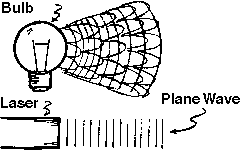
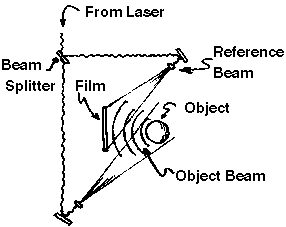

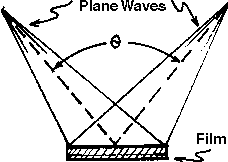
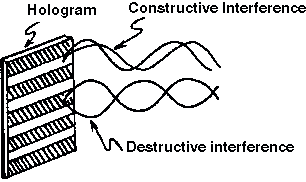
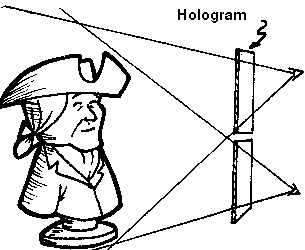
4. Movement
 On to Chapter 5
On to Chapter 5
 Holocom!
Holocom!